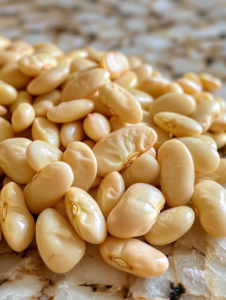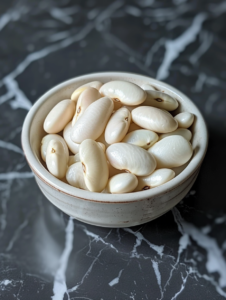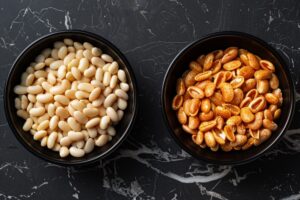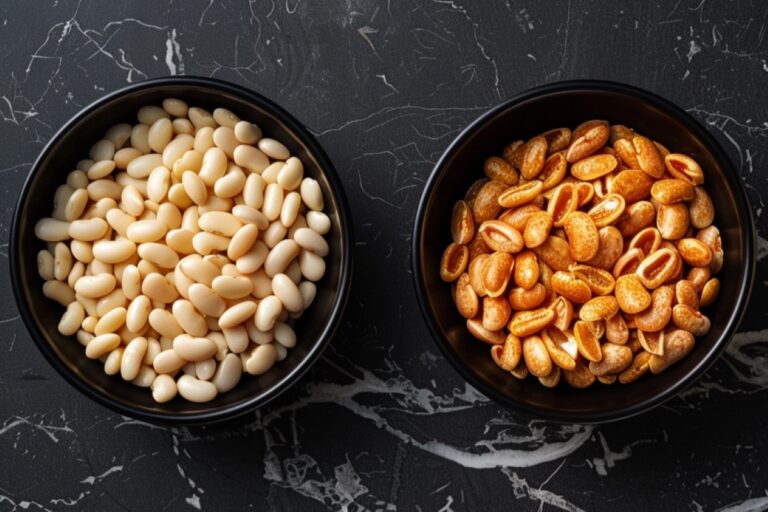Are you wondering if butter beans are good for your health? This article dives into the world of these creamy legumes, exploring their health benefits, nutritional content, and ways to incorporate them into delicious meals. Whether you’re a vegan seeking protein alternatives or someone trying to enhance your diet with more fiber and minerals, butter beans have something to offer. Let’s uncover the goodness of butter beans and discover how they can be a versatile and beneficial addition to your meals.
What Are Butter Beans?
Butter beans, also known as lima beans, are a delightful staple in many kitchens around the globe. Originating from South America, these beans are celebrated not only for their creamy texture and mild flavor but also for their impressive nutritional profile.
Key Nutritional Highlights
Butter beans are a powerhouse of nutrients. They are an excellent source of protein, making them a fantastic choice for vegans and vegetarians. Rich in dietary fiber, they promote a feeling of fullness and aid in digestion. What’s more, these beans are packed with essential minerals like potassium and iron, which are crucial for maintaining good health.
Butter beans come in various forms, including dried, tinned, and even organic options. Each form offers distinct benefits and uses in cooking. Dried butter beans, for instance, are perfect for those who prefer a firmer texture and enjoy the process of cooking beans from scratch. On the other hand, tinned butter beans are a convenient and quick option, ideal for busy individuals who still want to maintain a healthy diet.
Furthermore, these beans are not just nutritious but versatile. Whether incorporated into soups, stews, or salads, they adapt well to a wide range of dishes. By understanding the different types of butter beans available, you can choose the best type to suit your cooking needs and dietary preferences.

Incorporating butter beans into your diet is not just a step towards a healthier lifestyle but also a chance to explore new and exciting culinary adventures. Stay tuned as we delve into some scrumptious recipes in the next section that highlight the versatility of butter beans.
- beans with the robust flavors of traditional stew ingredients.
- Servings: 4
- Prep Time: 20 mins
- Cook Time: 45 mins
- Total Time: 65 mins
- Categories:
- Courses: Main Course
- Cuisines: Mediterranean
- Keywords: Healthy, Hearty, Nutrient-rich
- Equipment:
- Amount: 1
- Name: Large cooking pot
- Notes: Any large pot will do, but a Dutch oven is ideal for even cooking.
- Ingredients:
- Amount: 400g
- Unit: grams
- Name: Pre-cooked tinned butter beans
- Notes: Drained and rinsed
- Amount: 2
- Unit: tablespoons
- Name: Olive oil
- Notes: Extra virgin preferred
- Amount: 1
- Unit: each
- Name: Large onion, chopped
- Notes: Preferably yellow for sweetness
- Other ingredients include tomatoes, garlic, carrots, and herbs.
- Instructions:
- Heat the olive oil in a large pot over medium heat.
- Add the chopped onions and garlic, sautéing until translucent.
- Stir in the carrots and cook for a few minutes before adding the tomatoes and herbs.
- Finally, add the butter beans and simmer for about 45 minutes.
- Serve hot and enjoy!
- Nutrition: Calories per serving: Approximately 250
- Notes: This stew can be stored in the refrigerator for up to three days and tastes even better the next day as the flavors meld.
Refreshing Butter Bean Salad
A light, zesty salad that’s perfect for summer days or as a healthy side dish.
- Name: Refreshing Butter Bean Salad
- Summary: A crisp, tangy salad that combines butter beans with fresh vegetables and a vibrant dressing.
- Servings: 4
- Prep Time: 15 mins
- Total Time: 15 mins
- Categories:
- Courses: Side Dish
- Cuisines: Mediterranean
- Keywords: Fresh, Light, Quick
- Equipment:
- Amount: 1
- Name: Salad bowl
- Notes: Large enough to mix ingredients comfortably.
- Ingredients:
- Amount: 300g
- Unit: grams
- Name: Pre-cooked tinned butter beans
- Notes: Drained and rinsed
- Amount: 1
- Unit: each
- Name: Cucumber, diced
- Amount: 200g
- Unit: grams
- Name: Cherry tomatoes, halved
- Amount: 100g
- Unit: grams
- Name: Feta cheese, crumbled
- Other ingredients include red onion, parsley, and a lemon-olive oil dressing.
- Instructions:
- In a large salad bowl, combine all ingredients.
- Drizzle with lemon-olive oil dressing and toss gently to coat.
- Serve immediately or chill in the refrigerator for an hour before serving to enhance the flavors.
- Nutrition: Calories per serving: Approximately 180
These recipes not only provide a delicious way to enjoy butter beans but also offer a variety of nutrients that contribute to a healthy diet. For more breakfast ideas that incorporate nutritious ingredients like butter beans, check out these easy and nutritious recipes for breakfast stuffed bell peppers. Stay tuned for more insights on the health benefits of butter beans in the next section!
Health Benefits of Butter Beans
Butter beans are more than just a tasty addition to your meals—they are a powerhouse of nutrition that offers numerous health benefits. From improving digestive health to supporting weight management, let’s explore why incorporating butter beans into your diet can be a game-changer for your health.
Dietary Fiber and Satiety
Butter beans are an excellent source of both soluble and insoluble fiber. This not only aids in digestion but also helps maintain a feeling of fullness, which can be beneficial for weight management.
Protein Source for Vegans
For those following a plant-based diet, butter beans are a valuable source of protein. They supply the necessary amino acids required for repairing and building muscles.
Rich in Antioxidants
These legumes are loaded with antioxidants, which help combat oxidative stress and may reduce the risk of chronic diseases.
Blood Sugar and Cholesterol Management
Butter beans have a low glycemic index, which means they help stabilize blood sugar levels. Moreover, the significant amount of fiber they contain can help reduce cholesterol levels.
Table: Nutritional Benefits of Butter Beans
| Nutrient | Benefit |
|---|---|
| Fiber | Promotes digestive health and reduces hunger pangs |
| Protein | Supports muscle growth and repairs tissue |
| Antioxidants | Protects against oxidative stress |
| Low Glycemic | Helps control blood sugar levels |
| Cholesterol | Aids in lowering bad cholesterol levels |
Health Impact of Butter Beans
Table: Health Impact of Regular Consumption of Butter Beans
| Health Aspect | Description |
|---|---|
| Weight Management | High fiber content helps in feeling fuller longer, aiding in weight loss efforts |
| Digestive Health | Fiber aids in smooth digestion and prevents constipation |
| Muscle and Tissue Repair | Protein content supports the body’s repair mechanisms |
| Chronic Disease Prevention | Antioxidants help reduce the risk of diseases such as heart disease and diabetes |
| Heart Health | Fiber helps reduce cholesterol, benefiting heart health |
Including butter beans in your diet is not only a step towards more flavorful meals but also a stride towards better health. Whether you’re looking to boost your protein intake, manage your weight, or simply add more nutrients to your diet, butter beans offer a versatile and healthy solution. In the next section, we’ll dive deeper into the nutritional content of butter beans to better understand why they are considered a superfood.
Nutritional Content of Butter Beans
Butter beans, known for their creamy texture and mild flavor, are not only versatile in the kitchen but also offer a robust nutritional profile. Understanding the comprehensive nutrient composition of butter beans can help you appreciate why they are such a valuable addition to a healthy diet.

In-Depth Look at Butter Beans’ Nutrition
Butter beans are a low-calorie option that is rich in vital nutrients. They are an excellent source of protein, which is crucial for the building and repair of muscle tissues, making them an ideal choice for individuals following a plant-based diet. Moreover, these beans are packed with dietary fiber, which promotes a healthy digestive system and aids in maintaining a healthy weight.
Vitamins and Minerals
One of the standout features of butter beans is their rich vitamin and mineral content. They are a good source of essential minerals such as iron, which is necessary for making red blood cells and transporting oxygen throughout the body. Butter beans also provide magnesium, which supports muscle and nerve function, and potassium, which is vital for blood pressure regulation.
Furthermore, butter beans are rich in folate, a B vitamin that is essential for cell division and DNA synthesis, making them particularly important for pregnant women. They also contain zinc, which is crucial for immune system function and skin health.
Macronutrient Balance
Butter beans offer a balanced mix of macronutrients:
- Proteins: Essential for growth and repair of tissues
- Carbohydrates: Provide a slow-releasing source of energy due to their low glycemic index
- Fats: Contain mostly unsaturated fats, which are beneficial for heart health
This balance makes them an excellent food choice for anyone looking to maintain or improve their overall health.
Low in Fat and Calories
Despite their creamy texture, butter beans are low in fat and calories, which can help prevent weight gain. This makes them an ideal food for those managing their weight, providing a feeling of fullness and satisfaction without the high calorie count.
Health Promoting Properties
Butter beans’ combination of fiber, protein, and antioxidants gives them properties that can help manage and prevent various health issues, such as heart disease and diabetes. Their ability to help regulate blood sugar levels and cholesterol is particularly beneficial for those with metabolic health concerns.

Including butter beans in your diet means you’re not just enjoying a delicious ingredient; you’re also taking advantage of its numerous health benefits. As we continue to explore the versatility of butter beans, the next section will compare them to other popular beans and legumes, highlighting why they might be a superior choice for your culinary creations.
Butter Beans vs. Other Legumes
While butter beans are a nutritious choice on their own, it’s beneficial to compare them to other popular legumes to fully grasp their advantages. This comparison will help you understand how butter beans stack up against other beans in terms of nutrient content, culinary versatility, and health benefits.
Nutritional Comparisons
Butter beans are often compared to other beans such as black beans, chickpeas, and lentils. Here’s how they measure up in terms of key nutrients like protein, fiber, and essential minerals.
Table: Nutritional Comparison of Butter Beans with Other Legumes
| Legume | Protein | Fiber | Iron | Potassium | Calories |
|---|---|---|---|---|---|
| Butter Beans | 7.3 g | 6.2 g | 2.4 mg | 508 mg | 115 kcal |
| Black Beans | 8.9 g | 8.5 g | 3.6 mg | 611 mg | 130 kcal |
| Chickpeas | 7.1 g | 6.0 g | 2.7 mg | 477 mg | 120 kcal |
| Lentils | 9.0 g | 7.9 g | 3.3 mg | 731 mg | 115 kcal |
From the table, it’s evident that while butter beans are not the highest in any single category, they offer a well-rounded profile of nutrients that contribute to a balanced diet.
Culinary Flexibility
Butter beans’ mild flavor and creamy texture make them exceptionally versatile in the kitchen. They are softer and larger than many other beans, which makes them an excellent base for creamy soups and stews, as well as a great addition to salads and side dishes.
Butter Beans vs. Potatoes
Another interesting comparison is between butter beans and potatoes, especially considering their use as starchy carbohydrates in many diets.
Table: Nutritional and Culinary Comparison of Butter Beans and Potatoes
| Feature | Butter Beans | Potatoes |
|---|---|---|
| Calories | Lower calorie count | Higher calorie count |
| Protein | Higher protein content | Lower protein content |
| Fiber | Higher fiber content | Comparatively lower fiber |
| Versatility | Great in soups, salads, stews | Best roasted, mashed, or fried |
| Dietary Suitability | Excellent for gluten-free, vegan diets | Not suitable for low-carb diets |
As shown, butter beans provide a lower-calorie, higher-protein alternative to potatoes, making them suitable for those on gluten-free or vegan diets and those monitoring their carbohydrate intake.
Health Benefits Over Other Legumes
Butter beans excel in several areas:
- They are rich in folate, making them particularly beneficial for women of childbearing age.
- Their low glycemic index renders them appropriate for people who are controlling diabetes.
- The soluble fiber in butter beans helps lower cholesterol levels, beneficial for heart health.
By choosing butter beans, you’re opting for a legume that not only enhances your meals but also supports diverse dietary needs and health goals. In the next section, we’ll look into the best ways to cook and prepare butter beans to maximize their health benefits and culinary potential.
Best Ways to Cook Butter Beans
Butter beans are not only nutritious but also remarkably adaptable in the kitchen. Their preparation can vary widely, from simple boiling to incorporating them into complex dishes. Here, we explore some of the most effective methods to cook butter beans that enhance their flavor and preserve their health benefits.

Cooking Dried Butter Beans
Dried butter beans require a bit of preparation, but the effort is well worth it for the depth of flavor they provide. Here’s how to prepare them:
- Soaking: Soak the dried butter beans overnight in plenty of water. This decreases the time needed for cooking and improves the digestibility of the beans.
- Simmering: Drain and rinse the beans after soaking. Add them to a pot, cover with fresh water, and bring to a boil. Reduce the heat and let them simmer until tender, which typically takes about 90 minutes.
Using Tinned Butter Beans
For those short on time, tinned butter beans are a convenient alternative:
- Rinsing: Always rinse tinned butter beans under cold water to remove excess sodium.
- Quick Heating: Tinned butter beans are pre-cooked, so they only need to be heated. You can add them directly to soups, stews, or warm them in a saucepan with a bit of water or stock.
Creative Cooking Methods
Beyond boiling or heating, butter beans can be transformed into delightful dishes:
- Roasting: For a crispy, snackable treat, try roasting butter beans. Coat them lightly in olive oil and your preferred seasoning, then bake in the oven until they’re nice and crunchy.
- Mashing: Butter beans can be mashed to create a creamy base for dips or spreads, much like mashed potatoes but with more protein and fiber.
Culinary Tips
- Flavor Pairings: Butter beans have a mild flavor that pairs well with robust ingredients like garlic, tomatoes, and herbs such as rosemary and thyme.
- Texture Play: Their creamy texture makes them ideal for adding body to soups and stews without the need for cream or thickeners.
Special Cooking Tips
- Herb Infusion: When simmering butter beans, add a bouquet garni or some dried herbs to the cooking water to infuse them with additional flavors.
- Acidic Touch: Adding a splash of lemon juice or vinegar at the end of cooking can enhance the beans’ flavor and make them more digestible.
Cooking butter beans is an art that can lead to a variety of delicious and healthy dishes. Whether you’re looking to create a comforting stew for a chilly evening or a refreshing salad for a summer lunch, butter beans provide a nutritious and flavorful base. Next, we’ll look into the common questions people have about butter beans to help clear up any confusion and provide more insights into their versatility and health benefits.
FAQs About Butter Beans
Butter beans, with their creamy texture and nutritional benefits, often raise questions about their use, health implications, and culinary versatility. In this section, we address some of the most common questions to help clarify misconceptions and provide useful insights.
Are Butter Beans and Lima Beans the Same?
Yes, butter beans and lima beans refer to the same type of legume, though the name might differ based on regional preferences. For more insights on the differences and uses of butter beans and lima beans, check out this comprehensive guide on Skinny Taste.
Do Butter Beans Cause Gas?
Like many legumes, butter beans contain oligosaccharides, a type of carbohydrate that can lead to gas and bloating. However, there are ways to minimize these effects:
Table: Tips to Reduce Gas from Butter Beans
| Tip | Explanation |
|---|---|
| Rinse Well | Always rinse canned beans to remove some of the oligosaccharides. |
| Soak and Change Water | Soak dried beans and change the soaking water several times before cooking. |
| Cook Thoroughly | Ensure beans are cooked thoroughly to break down more complex sugars. |
| Eat in Moderation | Introduce butter beans gradually into your diet to allow your digestive system to adjust. |
How to Store and Keep Butter Beans Fresh?
Proper storage is crucial for maintaining the freshness and nutritional value of butter beans.
Table: Storage Tips for Butter Beans
| Form | Storage Method | Shelf Life |
|---|---|---|
| Dried | Keep in a cool, dry place in an airtight container. | Up to 1 year |
| Canned | Keep closed cans in a cool, dry spot. After they’re opened, refrigerate in a different container. | 3-5 days in the refrigerator |
| Cooked | Refrigerate cooked beans in an airtight container. | 3-4 days in the refrigerator |
Can You Eat Butter Beans on a Low-Carb Diet?
While butter beans are relatively high in carbohydrates, they are also rich in fiber and protein, which can be beneficial even in a low-carb diet, especially if consumed in moderation.
What Are the Best Ways to Incorporate Butter Beans into Meals?
Butter beans are incredibly versatile and can be added to a variety of dishes:
- In Soups and Stews: Their creamy texture thickens dishes naturally.
- Salads: Add cooked, chilled butter beans to salads for a protein boost.
- Mashed: Use them as a base for vegetarian patties or to thicken sauces.
By addressing these FAQs, we aim to enhance your understanding and appreciation of butter beans, promoting their use in diverse culinary contexts. In the next section, we’ll conclude with a summary of the health benefits and culinary versatility of butter beans, encouraging you to incorporate them into your diet more frequently.
